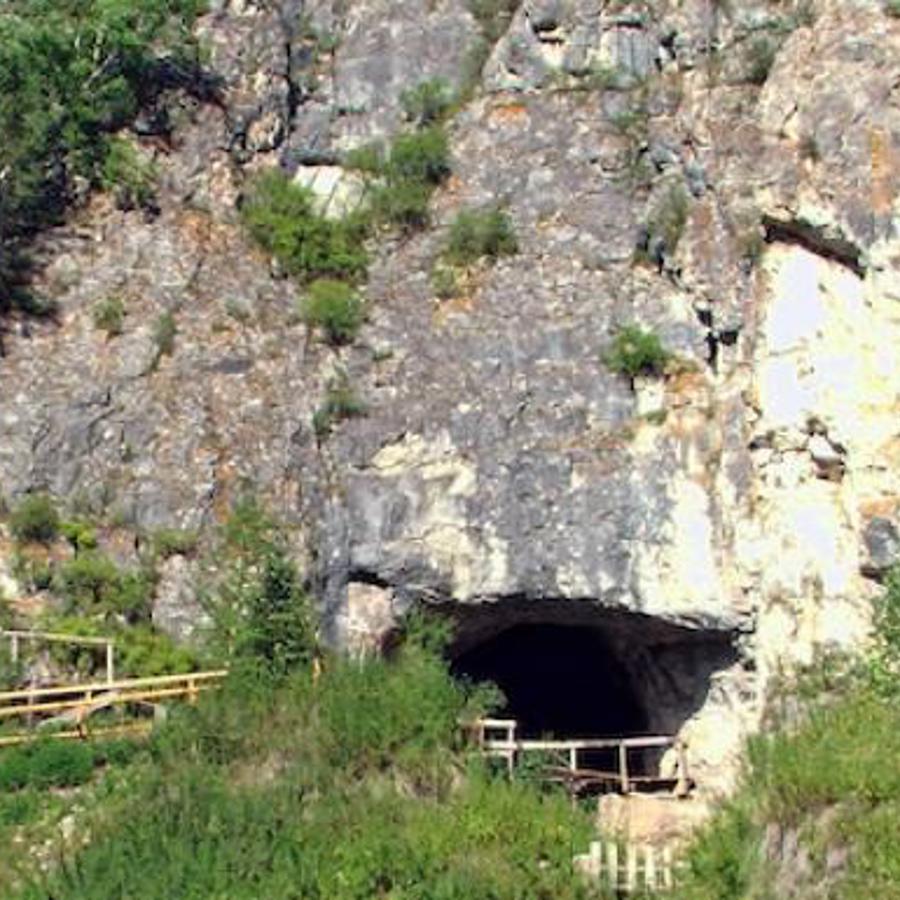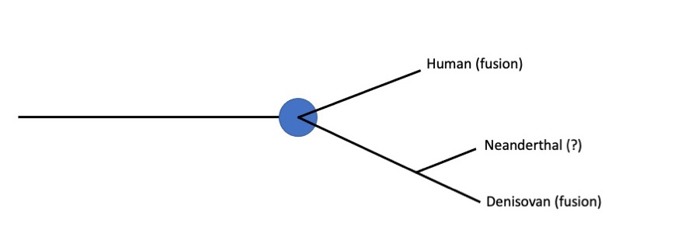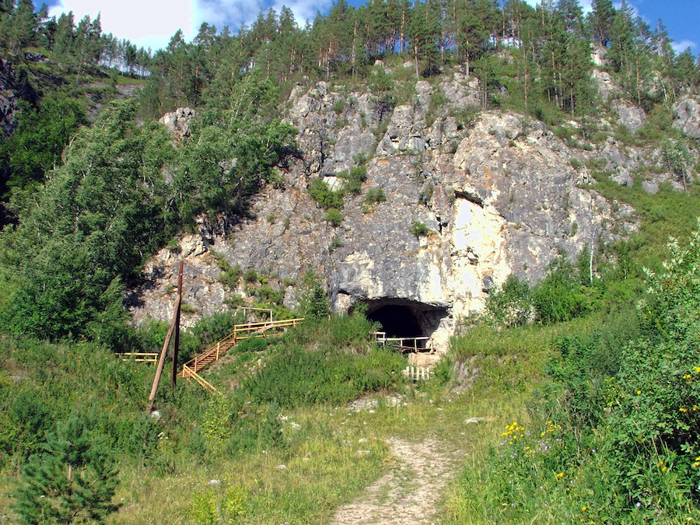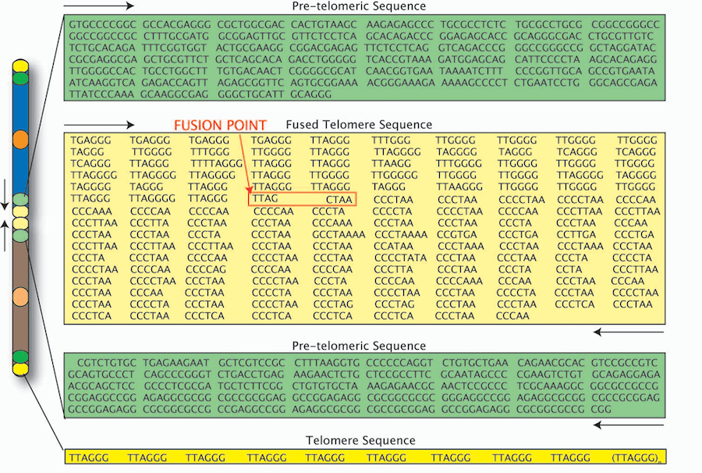
Do Neanderthal and modern humans both have 46 chromosomes?
October 30, 2013

- Related Topics:
- Ancient DNA,
- Comparing species,
- Human evolution,
- Population genetics,
- Chromosomes,
- Evolution,
- Neanderthals
A curious adult from California asks:
"Do Neanderthal and modern humans have the same number of chromosomes (46, instead of 48 like apes) and if so, has this fact been actually scientifically shown by fossil record or is it speculated by anthropology? Also at what point in time in human evolution it is believed that the fusion of chromosome 2 occurred?"
Editor’s Note (8/15/2021): Since this article was published, scientists have been able to study Neanderthal chromosomes. The author was correct in his prediction: Neanderthals did have a fused chromosome 2! Here is the study from 2017 that reported the discovery of a fused chromosome 2 in Neanderthals, just like the Denisovans.
As of now we don’t have any hard DNA evidence for how many chromosomes Neanderthals had. We are guessing that since humans and Neanderthals probably had babies together that they shared the same number of chromosomes. But this doesn’t necessarily have to be the case.1
We also don’t know if they had the specific fusion of the two ancestral chromosomes that led to human chromosome 2.1 But we actually do have evidence that a different related ancestor, a Denisovan, had the same fusion. So while we don’t know the number of chromosomes these ancient hominids had, we do know they shared this fusion with us.2
This tells us that the fusion happened at the very least before humans and Denisovans split apart. It also suggests that Neanderthals had the same fusion because Denisovans and Neanderthals have a common ancestor that split from humans.2 Here is what the branches look like:

So there was a common ancestor to all three that split into two branches. One branch led to humans and the other led to Neanderthals and Denisovans. Since humans and Denisovans have this fusion, this implies that Neanderthals (and the common ancestor) would too.
Other studies that were done before we had any Neanderthal or Denisovan DNA are also consistent with this. The estimate from these studies is that the fusion happened a bit more than a million years ago.3 This is well before these three split apart.
If you have been keeping up on all of the news about sequencing of ancient DNA, you might find it weird that we know so much more about Denisovans than we do about Neanderthals. After all, we’ve found lots of places with Neanderthal fossils but only one with Denisovans.
The difference is that a new technique was developed that vastly improves the data we can get from ancient DNA. We went from a 1950’s black and white image to an HD one in one fell swoop.
This new technique happened to have been done on the Denisovan DNA before it was done on Neanderthal DNA. It is only a matter of time before we have direct proof of whether Neanderthals had this fused chromosome or not.
For the rest of the answer I want to focus on how they could tell that the Denisovan had the equivalent of a human chromosome 2. Then I’ll briefly go over the innovation that allowed for the increased resolution of ancient DNA.

From 48 to 46
Humans have 46 chromosomes while our closest living relatives, chimpanzees and bonobos, have 48. As you can see in the image below, when we line up human and chimpanzee chromosomes, it is pretty easy to see what happened. Two chromosomes equivalent to two specific chimpanzee chromosomes fused together to create human chromosome 2.2,3

This is a big deal to a lot of people because they think it argues against evolution. It doesn’t. These kinds of things can and do happen and in fact, they are still happening today. For example, a man in China has 44 chromosomes because two chromosomes fused together. Under the right circumstances, he could be the founder of a new species!
OK, so that is living relatives. Unfortunately, current technology just isn’t good enough to tell how many chromosomes an ancient beast (or person) had. To do this, we need to be able to sequence the ends of the chromosomes and we simply can’t.
What we can do pretty well, though, is sequence the stuff in between. Which is why we can see the fusion in Denisovan DNA. Here is what the actual DNA looks like in modern humans:

As you can see, DNA is made up of four different letters — A, G, C, and T. The ends of chromosomes, called telomeres, are made up of the same six letters repeated many times over. Chromosomes also have a longer sequence of DNA just before the telomere called the “pretelomeric sequence” (shown in green).
What you can see in this part of human chromosome 2 is a pretelomeric sequence, two fused telomeres and then another pretelomeric sequence. This is exactly what you would expect if two chromosomes fused together relatively recently.4 And this is exactly what researchers saw in the Denisovan DNA. They saw nothing like it in chimpanzee DNA.2
So Denisovans and probably Neanderthals had the fusion and chimpanzees do not. As we are able to sequence more and more ancient DNA, we may get lucky and actually pinpoint when the transition happened. Admittedly this would require a lot of luck…
Better Sequencing Technology
As you might expect, ancient DNA is pretty beat up. It tends to be in small pieces with some of the letters chemically degraded. These degraded letters interfere with sequencing rendering these pieces of DNA unreadable.
Not only that, but a lot of the ancient DNA has been unzipped into single strands. Up until recently, scientists have needed for DNA to be double stranded to be able to read it. This is a whole lot more DNA that is unreadable.
So the pool of available ancient DNA ends up being pretty small when we get rid of degraded and single stranded DNA. That is where the new technology comes into play.
A scientist named Matthias Meyer came up with a clever way to sequence single stranded DNA. Now, suddenly, scientists have lots more DNA to look at.
Of course they can now read a lot of that single stranded DNA. But they can also read more of the degraded DNA.
The way that DNA is double stranded means that the same information is in both strands. Before, if a letter was damaged on one strand, the information on that piece of DNA was lost. But now scientists can get the information they need from the other strand.
So this is why we know that at least this one Denisovan had a fused chromosome like our chromosome 2. Once we use this technique on Neanderthal DNA, we’ll know if they had it too.

Author: Dr. D. Barry Starr
Barry served as The Tech Geneticist from 2002-2018. He founded Ask-a-Geneticist, answered thousands of questions submitted by people from all around the world, and oversaw and edited all articles published during his tenure. AAG is part of the Stanford at The Tech program, which brings Stanford scientists to The Tech to answer questions for this site, as well as to run science activities with visitors at The Tech Interactive in downtown San Jose.
 Skip Navigation
Skip Navigation
